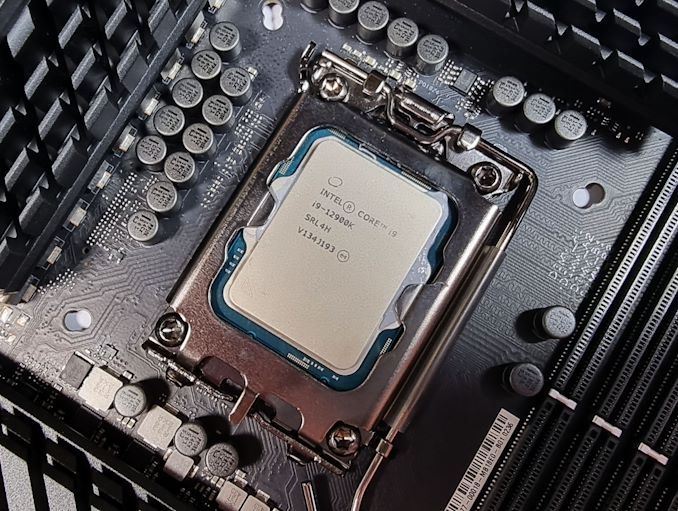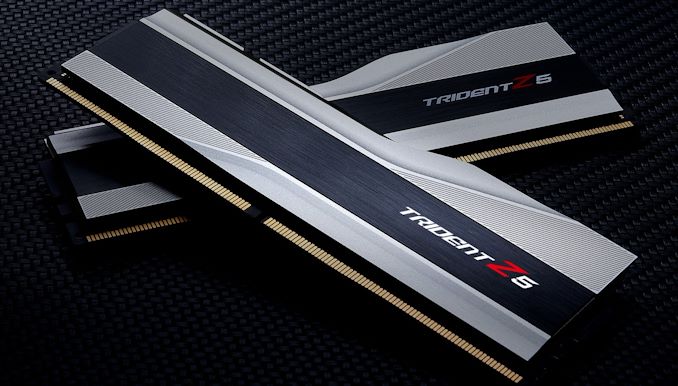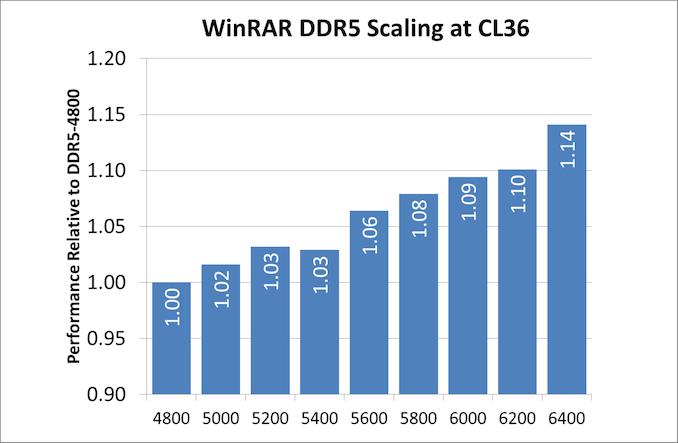Intel Alder Lake DDR5 Memory Scaling Analysis With G.Skill Trident Z5
by Gavin Bonshor on December 23, 2021 9:00 AM ESTDDR5 Memory Scaling on Alder Lake Conclusion
The launch of Intel's Alder Lake has enabled options for users to consider. One of them is the Intel Z690 chipset, which supports either DDR4 memory or the latest DDR5 memory, albeit not on the same motherboard. This means the most premium Z690 models support DDR5 memory because the best hardware needs the best components to be the best. The more 'value-orientated' Z690 models typically have variants for either DDR5 or DDR4 support, with DDR4 still widely available to purchase.
Ultimately when it comes down to performance, as per our Core i9-12900K review, DDR5 memory has a superior advantage to DDR4 in mostly heavy multithreaded scenarios. With the uplift in memory overall memory bandwidth coupled with the potential for even faster memory, SK Hynix announced last year that it was planning to produce up to DDR5-8400 memory. The sky is the limit. We've reached the pinnacle of DDR4 in terms of performance across multiple AMD and Intel platforms, but now it's the time for DDR5 to make its mark, despite the fact it's only supported on Intel's Alder Lake architecture at the time of writing.

The Intel Core i9-12900K processor (Alder Lake)
The biggest question we wanted to address within this article are, 'how does DDR5 scale with frequency'.
Increasing Memory Frequency, The Performance Isn't Linear
Deciphering the bigger picture from our variety of CPU/motherboard tests and benchmarks from our suite shows that increasing memory frequency, for the most part, from DDR5-4800 to DDR5-6400, doesn't play as much of a critical role as first thought. Going from DDR5-4800 to DDR5-6400 in terms of raw MT/s is a 33.3% jump. The effect in the increase of frequency doesn't in any way relate to the real-world impact and performance increase, if any at all.
This is down to the design of Intel's Alder Lake - the bottleneck is usually somewhere else in the system. Even the infancy of the operating system and new scheduler might play a role more than the memory. Our results paint quite a simplistic picture for the most part, with three main points to take away:
- 1. CPU intensive benchmarks with smaller memory workloads provided zero uplift
- 2. Benchmarks where memory workloads were higher show benefit from higher frequencies/tighter latencies
- 3. Games we tested benefitted from increased memory speed and tighter timings, but we're more likely to see a bigger improvement from an increase in CPU frequency or GPU frequency.
Taking our results from our Shadow of the Tomb Raider benchmark testing at 1440p, we barely saw an increase of 3.7% in average framerate from DDR5-4800 CL36 to DDR5-6400 CL36, with a 4% increase in the 95th percentile performance. There was a small uplift, even with the somewhat noisy results.
The TLDR of it comes down to one main point, there are a lot of titles out there, some more CPU intensive, some more reliant on graphical power. Memory frequency does play a part in uplifting that performance slightly. It might be a small part of the overall grand scheme of things, but it's still increasing performance whatever way you look at it.
Looking at the results of our WinRAR 5.90 testing, this is where we saw the most significant variation in performance from top to bottom. Going from DDR5-4800 CL36 to DDR5-6400 CL36, we saw an uplift in performance of just over 14%. What's very interesting from our testing is when we went low latency at DDR5-4800 with CL32 latencies. Tightening up the primary latencies at the same frequency netted us an additional 6.4% jump in performance, which shows there that increasing frequency isn't the only way to improve overall performance.
DDR5 Memory Pricing and Availability
One of the most frustrating aspects of building a new system or upgrading to the latest generation is availability. The current global chip shortage has made things very difficult, not just for consumers but for manufacturers too. This has resulted in low stock worldwide of computer components from processors, memory ICs, and graphics cards; yes, the mining craze has also played a massive part in gobbling up all of those precious high-performance GPUs. For memory, the issue isn't DDR5 chips themselves, but the power management controllers each module needs. There isn't enough to meet market demand.

The G.Skill Trident Z5 DDR5 memory in silver and black
Looking at the pricing and availability of the G.Skill Trident Z5 DDR5-6000 32GB (2x16) memory kit, it's available for around $430 at the time of writing. Trying to find any value in DDR5 at the moment is difficult to justify, and it's even harder to get a solid baseline on pricing, given demand outweighs the current supply. This inherently pushes pricing up to uncomfortable levels.
Comparing a kit of G.Skill Trident Z Neo DDR4-4000 CL18 32 GB (2x16) kit which currently costs around $169, the G.Skill Trident Z5 DDR6-6000 CL36 kit with the same capacity costs roughly 154% more. This large hike in price doesn't come close to the increase in performance, and as we've mentioned previously about linear performance, it's just not a subjective area to make fair comparisons. Pricing for DDR5 and trying to find value in it at the time of writing is sadly nonexistent.
Also yes, we've seen DDR5 memory kits on eBay going for over $1000. That is somewhat insane.
Final Thoughts
Since the launch of Intel's 12th generation Alder Lake processors, the availability of the processors has been relatively decent for a new launch. The biggest issue to unlocking many of the memory performance benefits is that DDR5 stock hasn't been available, unless you're willing to pay almost double the DDR4 equivalent cost. This means that users looking to use Alder Lake have had to either wait for DDR5 stock or opt for DDR4 and a relative Z690 motherboard.
While there is still value to be had from DDR4 on Alder Lake, as it's much more cost-effective, we typically always recommend holding out for the newer memory. It means the hardware has better resale value, and provides a platform for future improvement. Buying into DDR4 now means you're investing in a platform that has reached the ceiling. But in this market, perhaps just being able to buy what is available matters more. Opting for DDR4 memory, Alder Lake, and a compatible Z690 motherboard will still yield benefits over previous generations, but it's clear from our testing so far that going for DDR5 does perform better. Although the scalability of DDR5 is not as large in our testing as a user might first think, there's still much more room left in terms of raw MT/s left for manufacturers to eke out. The question is whether any of our usual software actually sees that as a bottleneck these days,
We've got some additional vendor memory kits in for testing, which we'll put into a review early next year. Stay tuned for that.











82 Comments
View All Comments
TheinsanegamerN - Tuesday, December 28, 2021 - link
What is the hold up on video card reviews? I know there was that cali fire last year, but that was over a year ago now.gagegfg - Thursday, December 30, 2021 - link
The shortage of Chips is global and not just GPU. A Hardware tester like you, should not have problems in acquiring a GPU to do these tests, otherwise, you have a serious public relations problem.And returning to the point of my criticism, I think that those who understand why CPU scaling is tested in games, it is not only FPS, but also being able to evaluate longevity to upgrade to future GPUs or which CPU will generate a bottleneck sooner. that other. Today all CPUs can run games at 4k and that's not news to anyone.
In short, if you cannot get a decent GPU to test a top-of-the-range CPU and its limitations with different hardware combinations, try to eliminate the GPU bottleneck with 720p / 1080p resolutions or by dropping detail from excene. That is the correct way to test the other points and not the GPU itself.
This criticism is constructive, and is not intended to generate repudiation.
TheinsanegamerN - Monday, January 3, 2022 - link
Erm, you do know that other reviewers have been able to get ahold of GPUs for testing, right? If you dont have the budget for the stuff you need to do your job, cant get the stuff you need to do your job, and find excuses to now do the reviews your viewerbase wants to so, that says to a lot of people that anandtech is being mismanaged into the ground.Come to think of it, these same excuses were used when the 3080 was never reviewed, alongside "well we have one guy who does it and he lives near the fires in cali". That was a year and a half ago.
Perhaps Anandtech presenting excuses instead of articles is why you cant get companies to send you hardware? Just a thought.
Azix - Monday, January 10, 2022 - link
I can understand manufacturers being less likely to send out a GPU if they aren't guaranteed publicity. The key is that he said just for testing, not necessarily for a review. Most other reviewers are given for marketing purposes.zheega - Thursday, December 23, 2021 - link
I didn't even notice that at first, I just assumed that they would get rid of the GPU bottleneck. How amazingly weird.thestryker - Thursday, December 23, 2021 - link
The vast majority of people play at the highest playable resolution for the hardware they have which means they're GPU bound no matter what their GPU is. The frame rates in the review are perfectly playable and indicates the amount of variation one could expect for a mostly GPU bound situation. None of the titles are esports/competitive where you'd need to be maxing out frame rate so even if they were using a 3090 it'd be a pointless reflection for that.So while the metrics aren't perfect from a scaling under ideal circumstances perspective it's perfectly fine for practicality.
haukionkannel - Friday, December 24, 2021 - link
True. I have not latest PC hardware and still play at 1440p at highest settings. So I can confirm that is the way to test to see what we see in real world situation...Ooga Booga - Tuesday, December 28, 2021 - link
Because they haven't done meaningful GPU stuff in years, it all goes to Tom's Hardware. Eventually the card they use will be 10 years old if this site is even still around.TimeGoddess - Thursday, December 23, 2021 - link
If youre gonna use a gtx 1080 at least try and do the gaming benchmarks in 720p so that there is actually a CPU bottleneckIan Cutress - Thursday, December 23, 2021 - link
You know how many people complain when I run our CPU reviews at 720p resolutions? 'You're only doing that to show a difference'.